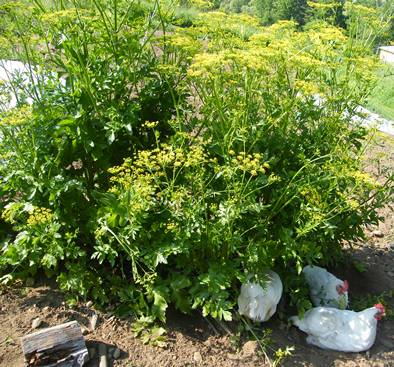We’ve probably been using gardens as metaphors ever since humans began tending them.
What happens in the garden—love and nurturing; pests and pestilences; drought and drowning; death and dying and rebirth; never-ending change; and, despite our illusions of mastery, so very little of it actually under human control—mirrors what goes on in the other areas of our lives.
My garden is surely a metaphor for the rest of my life. You’d never mistake it (or for that matter, my home) for one of those spreads in a home-and-garden magazine, where every plant thrives and yields and readers are encouraged to believe that quackgrass never encroaches and nothing dies or droops, goes to seed, fails to germinate, or gets smothered by invasive weeds, infested with worms, or afflicted with blights.
No magazine would choose to feature the sight of my young winter squashes, cantaloupes, and sweet potatoes peeking out from openings in a several patches of ugly black plastic that I rescued from a farmer who’d used it to cover corn silage over the winter and was about to haul it to the dump.
Or those lengths of recycled carpet scraps, cardboard, and old newspaper spread under the woodchuck-zapping cords of the electric fence to prevent the weeds and quackgrass from shorting them out.
Or the bed of carrots that, after a month of rain and soil too boggy to walk on, have disappeared into a bed of 6-inch-tall weeds and grasses.
Or the ratty milkweed coves I’ve allowed to grow up around the garden edges as food for the monarch butterfly larvae.
Thriving on Benign Neglect
A magazine wouldn’t show the chaotic domains of what I call my un(in)tended garden either, which emerged from benign neglect a few decades ago.
In the year when my daughter was born—when I hardly ever ventured into the quarter-acre I had planted before her birth—I discovered the “virtues” of letting (some) things go.
Behold: The following April, fresh, tender kale sprouted from the stems of the previous year’s planting. Three or four varieties of leaf lettuce, along with dill, cilantro, and parsley, emerged from crops that had gone to seed. What I now call my salad cove has been seeding and reseeding every year since.
These volunteers provide us with fresh salad greens and herbs until they send up seed stalks, usually just as the asparagus and edible-pod peas come in.

Volunteer parsnips and my chickens
Volunteer sunflowers, calendulas, zinnias, marigolds, and California poppies pop up to please the bees and beautify the garden. Yesterday, I noticed a few sturdy volunteer tomatoes coming up in the asparagus bed and squash sprouting around the edges of the compost pile.
Big surprises come from the seeds of hybrid crops, often in the form of bizarre combinations of their parent varieties.
Last year we harvested many delicious, pale-green “zucchini” from one of the volunteer squash plants before forgetting about it when the tomatoes, corn, and fresh peppers came in. I rediscovered it in September, when I stumbled over a mature fruit the size of a swollen baseball bat, a vibrant pumpkin-orange color with deep green streaks. Stunning—but not all that tasty.
Like Garden, Like House
Volunteers flourish in the house, too. They show up and I sometimes embrace them. For example, those spider webs that collect in the corners of walls and windows: With a school-aged child in the house, voila! A few free minutes of entertainment. The rest of the time, they do a great job of insect control.
And yes, invasives encroach from all quarters in a wood-heated home with a dirt driveway, whose kitchen communicates with a food-producing greenhouse. Sawdust, woodchips, ashes, dirt, and dust kitties. I occasionally sweep them up and add them to the compost bucket, where I figure they make up for the dryer-lint deficit, since we don’t own a clothes dryer.
Speaking of clothes-drying, a couple of weeks ago I ordered some cheap, fitted bed sheets online. They came in only one color: dead white.
Oops! Watching them swing in the breeze along with the rest of the day’s laundry, I laughed at how out of place they seemed alongside the rest of our bedding, shirts, towels, curtains and underwear in shades of best described as ash, nimbostratus, toast, ambergris, and humus.
We’re typically too lazy to separate the wash, and while our homemade laundry products are effective, they don’t include bleach or stain removers.
“Oh well,” I thought. “After a few more washes, they’ll no doubt mellow into one of those soft grays that blend so well with our decor. And the gray sheet won’t detract from the quality of our sleep at all.”
So, do you have a gardening philosophy? Do you let nature take its course or carefully plan out your garden?












